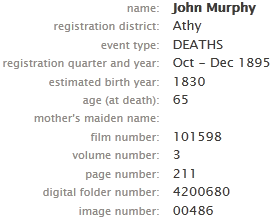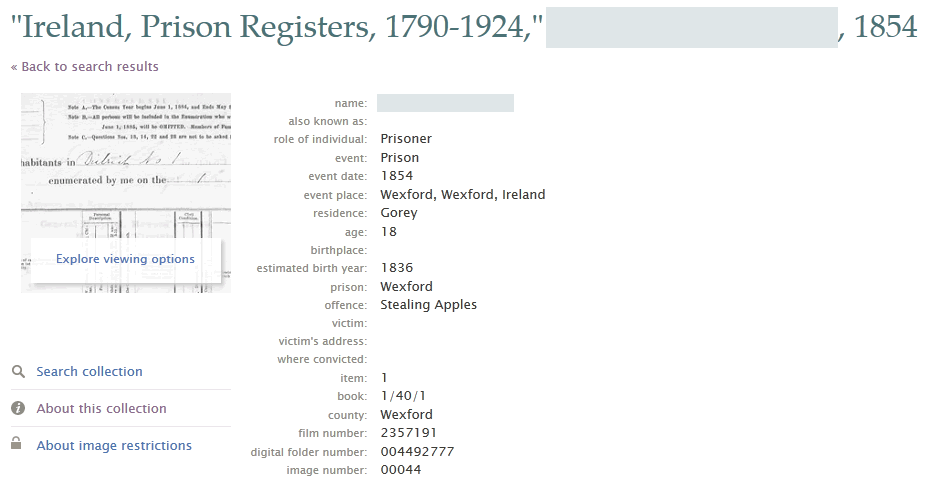I’m having great fun this afternoon searching through the newly available online index of the GRO’s civil registers of births, marriages, civil partnerships and deaths on IrishGenealogy.ie, and finding a few things that I never quite managed to pin down on familysearch.org.
Tag: Genealogy
Mapping Where Your Ancestors Came From
Whenever I discover a new likely ancestor who was born, married, or died in a townland or parish I’ve not heard of before, I have to call my mum to ask whether it’s likely we had family living there. 9 times out of 10, she can tell in an instant that there’s no way we’d have people there, or that I’m on to a sure thing. And sometimes a place name that hasn’t come up before will bring out some forgotten family connections or names and relationships, opening up a treasure trove of research opportunity.
My mum knows the lie of the land like the back of her hand; I haven’t a clue, and just can’t seem to retain the information she patiently imparts, over and over and over again.
So, recently I decided to try Google before plaguing her once more on where such-and-such-a-place was in relation to such-another-place, where we definitely had family, and I came upon this wonderful resource: an interactive map of Irish counties, baronies, civil parishes and townlands!
Researching your Irish Family Tree – Part 3
Another quick, timely post, on Irish genealogical resources.
Recently, the good people at FamilySearch.org, in conjunction with the other good people at findmypast.ie, have made the Irish Prison Registers, 1790-1924 available online.
The FamilySearch site, which has had a mention here before, is a free resource. Under this category, they provide a summary of any matching prison record on their website – and you can visit one of their centres to see an image of the original record.
A sample record for some poor sod who went to prison for stealing apples in 1854 is shown below (name obscured to protect the guilty) – what a thing to go to prison for!
Details recorded include the individual’s name, aliases and age, and the offence, event date and place.
Interestingly, when I searched for the same individual on findmypast.ie, a paid resource, it didn’t show up any matches under prison registers, but it did return a bundle of other records involving possibly the same individual as both a defendant and witness in court records.
Anyway – I’m off now to have a bit of fun finding out whether any of my ancestors got up to any interesting naughtiness. If you find anything exciting in your own family history, do share in the comments! 🙂
Researching your Irish Family Tree – Part 2
I gave a mention to a number of useful free resources for people researching their Irish family trees in an earlier post.
This morning, I’d like to give a quick mention to a paid resource I’ve found useful: RootsIreland.ie. They have a special offer on for the month of July, 2012, which is worth taking advantage of – more below.
RootsIreland.ie has over 19 million Irish records in the following categories:
- Baptismal/Birth Records
- Marriage Records
- Burial/Death Records
- Census Records (you can search these for free at www.census.nationalarchives.ie instead)
- Gravestone Inscriptions
- Griffith’s Valuation (you can search this for free at www.askaboutireland.ie/griffith-valuation instead)
- Passenger Lists
Records on this site span the period 1700-1920, and include births, deaths and marriages from parish records. Since Irish civil registration only goes back to 1864 (or 1845 for non-Catholic marriages), once you’ve got a few names back that far, this will help you get back a bit further. Not all areas are covered, but most of the country is. (See this map on their website for an indication of coverage.) Do check whether you can actually expect to find anything for the county/ies you’re interested in before spending any money.
I haven’t really looked at the gravestone inscriptions or passenger lists so far, so can’t comment on their usefulness. The other two record types (census records and Griffith’s valuation records) are available for free elsewhere, as noted above, so I’d recommend concentrating on early births, deaths and marriages on this site.
When you register with RootsIreland, you buy credits, and credits can be exchanged to view pages of search results, or individual records. Usually, a page of results (10 results per page) costs one credit, but for the month of July, you get one free page of search results for each credit you’ve purchased. In addition, all new users get 10 pages of search results for free when they register. The cost of viewing an individual record varies depending on the record type, but for births, deaths and marriages, it’s 25 credits.
Pricing details from their website:
| Purchase Amount | Amount of Credit | Cost per Credit |
| €5.00 | 35 credits | 0.14 |
| €10.00 | 73 credits | 0.13 |
| €18.00 | 150 credits | 0.12 |
| €32.00 | 320 credits | 0.10 |
| €60.00 | 750 credits | 0.08 |
So in July, if you buy 35 credits for €5, you get to view 35 pages of search results for free (plus an extra 10 if it’s your first time registering with the site), and only use your purchased credits to view individual records if you find results that look like they’re what you’re after.
This page on their site illustrates the type of information you can expect to see for each record type, though the amount of data recorded does vary from record to record.
I found this site invaluable in moving back a generation or two with my family tree – I hope you find it useful too.
Researching your Irish Family Tree – Part 1
My mum in law is very into genealogy, and managed to get me hooked on it when I was on maternity leave a couple of years ago. Well, for the couple of months before baby arrived, at least: once he was here, all time for such things went out the window. But I’m finally finding a few spare moments now to get back into it.
There’s more and more information becoming available online all the time, so you can do a lot from the comfort of your home. I’ve managed to fill in the direct line back as far as quite a few of my great-great-great grandparents on both sides now, with most of the info coming from online, and I’m starting to fill in brothers and sisters.
So, while I’m in the zone, I thought I’d share a few of the resources I’ve been using, and maybe you’ll get the bug too.
First off, some free sites that will get you started:
- The National Archives Censuses of 1901 and 1911. These are a good place to start, as chances are you’ll be able to ask living relatives for enough information to find definite matches. In both censuses ,on the A form you’ll get the registered people’s full names, relationship to head of household, religion, literacy level, age, profession, marital status, birthplace, use of the Irish language, and whether they have one of a specified list of disabilities. The 1911 census includes a wee bit more information: how many years of marriage are completed, total number of children born alive, and number of children still living. If you’re happy you’ve got a match, you can take a look at the B forms too, and find out more about the house and extended property your ancestors lived in/on.
- If you’re lucky enough to have ancestors in Carlow (CoI only), Cork & Ross (RC only), Dublin or Kerry, Irish Genealogy have digitised church records for these areas, so you may be able to track down births, deaths and marriages for some of the people you’ve found in the censuses. If you say you want to see births for a certain name, you’ll be shown all birth records that include that name, either as the child, a parent or a sponsor. There was a tendency back in the day (in my family at least!) to have a bundle of children about two years apart, so once you’ve found a birth and parent names for one ancestor, you can search for one or both of the parents on birth records in or around the same timeframe to get a set of siblings. Relatives often stood as sponsors, so recurring names here can tip you off to further family connections.
 FamilySearch.org is a service provided by The Church of Jesus Christ of Latter-day Saints, aka the Mormons. It’s very thorough, and you stand a very good chance of finding something useful on here. The type of information returned depends on the resource. There’ll always be some kind of textual summary, and there may be a link or reference to where you can find more information (free or paid). For Irish births, deaths and marriages, keep an eye out for returns that show an event type, name, registration district, quarter and year, volume number and page number (as illustrated above for a random John Murphy – no relation). Jot these down, make your way to the General Register Office (GRO) in the Irish Life Mall between Talbot St and Abbey St in Dublin, and for the princely sum of €4, you can get a copy of the original registration entry for the event, which will contain more information to help you identify whether or not this is the person you’re looking for, and hopefully point you in the direction of more people to follow up. If you’re trying to do things on the cheap and are looking for marriage records, do this search for both husband and wife – if you get a match on district, year, quarter, volume and page, chances are you’ve found the pair.
FamilySearch.org is a service provided by The Church of Jesus Christ of Latter-day Saints, aka the Mormons. It’s very thorough, and you stand a very good chance of finding something useful on here. The type of information returned depends on the resource. There’ll always be some kind of textual summary, and there may be a link or reference to where you can find more information (free or paid). For Irish births, deaths and marriages, keep an eye out for returns that show an event type, name, registration district, quarter and year, volume number and page number (as illustrated above for a random John Murphy – no relation). Jot these down, make your way to the General Register Office (GRO) in the Irish Life Mall between Talbot St and Abbey St in Dublin, and for the princely sum of €4, you can get a copy of the original registration entry for the event, which will contain more information to help you identify whether or not this is the person you’re looking for, and hopefully point you in the direction of more people to follow up. If you’re trying to do things on the cheap and are looking for marriage records, do this search for both husband and wife – if you get a match on district, year, quarter, volume and page, chances are you’ve found the pair.
OK – now I’ve started you down the spending money path, so let’s break and reconvene another time to look at a few more resources.


